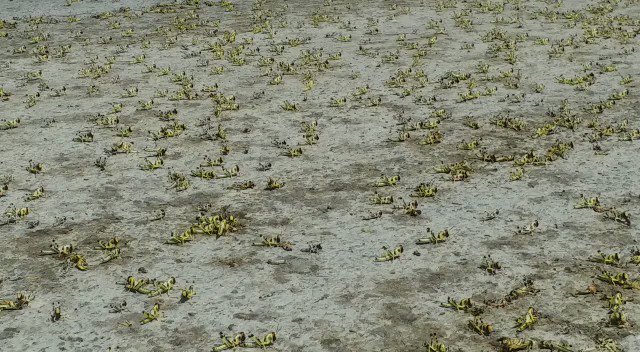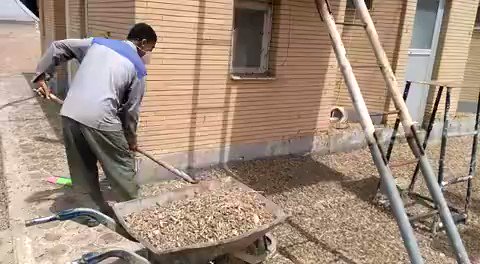Iran faces worst locust plague
in 50 years, recent attacks
unprecedented

28 May, 2020
Iran is under its worst desert locust outbreak in the past 50 years and for the second year in a row. Compared with last year, the swarms of desert locusts are much larger, and it is safe to claim that the recent attacks are unprecedented, officials said.
According to the Food and Agriculture Organization's (FAO) situation update on May 27, 2020, adult locusts are forming groups and small swarms in spring breeding areas along parts of Sistan-Baluchistan and the southern coast area as vegetation is drying out.
FAO noted that the infestations will continue moving east to the Indo-Pakistan summer breeding areas. With the worsening situation, Iran may deploy its military to help contain the invasion in the country's southern region.
The outbreak is adding to problems the nation is facing amid its battle against the coronavirus pandemic, as well as the economic turmoil following ending U.S. sanctions.
An official of the Iranian Agriculture Ministry said the military has offered to assist in combating locusts for the second year in a row.
"Compared with last year, the swarms of desert locusts are much larger, and it is safe to claim that the recent attacks are unprecedented," said the secretary of the Chabahar Agricultural Trade Union.
"Last year the military provided personnel and vehicles, and that was a big help."
The provinces of Sistan-Baluchistan, Bushehr, Fars, Hormozgan, Kerman, and Khuzestan have been under the attacks. As of May 28, reports said around 260 000 ha (640 000 acres) have been treated so far.
FAO has delivered 25 vehicle-mounted Ultra Low Volume (ULV) sprayers worth about 125 000 dollars. An updated appeal by the organization also requests 17.5 million dollars to control 800 000 ha (2 million acres) of lands, so far funded with 1 million dollars.
Based on the agricultural calendar, there is a chance to scale up operations by the end of July to lessen harvest damage. This is also key to reduce locusts' migration to Pakistan and India.
Although FAO's appeal extends until the end of this year, prompt support is needed for both the immediate scale-up until the end of July and to preposition equipment for when locusts occur again in November.
Featured image credit: FAO Emergencies
As the world watches Covid-19, massive swarms of locust are exploding due excessive rains, the largest plague in almost 100 years have reached numbers that are unfathomable and continue to grow

Severe rains and cyclones are ideal conditions for locust breeding. As climate change is making extreme weather more common, preventing locusts from becoming swarms is increasingly important. @FAO/Sven Torfinn
While the eyes of the world are on the novel coronavirus, an enormous stretch of the globe from East Africa all the way to India, countries, among them some of the poorest in the world continues to struggle with another crisis, growing swarms of ravenous locusts on a Biblical scale. The swarms are the largest in almost 100 years. Both crises are extraordinary in size, and both foes multiply so quickly that governments are struggling to contain them.
On January the 11th, 2019, the holiest site in Islam was swarmed by a plague of locusts, forcing cleaners into action to drive the insects out. The Great Mosque in Mecca, which hosts millions of Muslim pilgrims every year and is the holiest site in Islam was the birthplace of a plague which in just over 12 months would grow into billions, stretching from the western border of China sweeping through Bangladesh, India and Pakistan, through Arabia the Middle East, northern Africa and all the way down to Southern Africa. TBW.
The numbers and size of the plagues are unfathomable, we are talking billions of the most ravenous beast known to man, just a small swarm can eat enough food to feed a city of 35,000 people. These swarms are currently invading the poorest and most food-insecure people on the planet
Desert Locust upsurge remains critical in East Africa, Yemen and Southwest Asia according to fao.org.
The current situation remains extremely alarming in East Africa where Kenya, Ethiopia and Somalia continue to face an unprecedented threat to food security and livelihoods. New swarms from current breeding will form from mid-June onwards, coinciding with the start of the harvest. Thereafter, there is a risk that swarms will migrate to the summer breeding areas along both sides of the Indo-Pakistan border as well as to Sudan and perhaps West Africa.
While the eyes of the world are on the novel coronavirus, an enormous stretch of the globe from East Africa all the way to India, countries, among them some of the poorest in the world continues to struggle with another crisis, growing swarms of ravenous locusts on a Biblical scale. The swarms are the largest in almost 100 years. Both crises are extraordinary in size, and both foes multiply so quickly that governments are struggling to contain them.
On January the 11th, 2019, the holiest site in Islam was swarmed by a plague of locusts, forcing cleaners into action to drive the insects out. The Great Mosque in Mecca, which hosts millions of Muslim pilgrims every year and is the holiest site in Islam was the birthplace of a plague which in just over 12 months would grow into billions, stretching from the western border of China sweeping through Bangladesh, India and Pakistan, through Arabia the Middle East, northern Africa and all the way down to Southern Africa. TBW.
The numbers and size of the plagues are unfathomable, we are talking billions of the most ravenous beast known to man, just a small swarm can eat enough food to feed a city of 35,000 people. These swarms are currently invading the poorest and most food-insecure people on the planet
Desert Locust upsurge remains critical in East Africa, Yemen and Southwest Asia according to fao.org.
The current situation remains extremely alarming in East Africa where Kenya, Ethiopia and Somalia continue to face an unprecedented threat to food security and livelihoods. New swarms from current breeding will form from mid-June onwards, coinciding with the start of the harvest. Thereafter, there is a risk that swarms will migrate to the summer breeding areas along both sides of the Indo-Pakistan border as well as to Sudan and perhaps West Africa.
Credit fao.org
EAST AFRICA In Kenya, more hopper bands have been detected in the northwest where control operations are ongoing. Mature swarms are still present in some places and a few of these swarms moved into southeast South Sudan (Kopeata East district) on 14 May and northeast Uganda (Moroto district) on the 20th.
In South Sudan, earlier breeding is in progress near Torit. In Sudan, mature gregarious adults reached the White Nile region on the border with South Sudan on the 15th. In Ethiopia, control operations continue against breeding in the south as well as hopper bands and several mature swarms further north in the Somali region near northwest Somalia.
In Somalia, new hatching started in the past few days in central (Galmudug), northeast (Galkayo), and northwest (Somaliland) areas. In Sudan, rains are forecasted in the southern portion of the summer breeding areas (South Kordofan, White Nile) during the last week of May and again in the second and third weeks of June. If this occurs, then breeding conditions should be improving when swarms are likely to arrive from Kenya and Ethiopia after mid-June.
ARABIAN PENINSULA In Yemen, widespread breeding is underway in the interior and hopper bands are forming. Survey and control operations have yet to be undertaken. A substantial increase in locust populations is expected in June that could eventually threaten the Horn of Africa.
In Saudi Arabia, control operations are in progress against immature adults groups that formed in the Nafud Desert in the north and mature adult groups in the south near Yemen. Similarly, control operations continue against immature adult groups in northern Oman near UAE.
SOUTHWEST ASIA Spring breeding continues in southern Iran and southwest Pakistan where control operations are in progress against hopper groups and bands as well as an increasing number of adult groups. As vegetation dries out, more groups and swarms will form and move from these areas to the summer breeding areas along both sides of the Indo-Pakistan border as several waves from now until at least early July. Good rains are predicted during the first half of June along the Indo-Pakistan border that would allow egg-laying to occur. This should reduce the further eastward movement of swarms that have already arrived in Rajasthan, India.
WEST AFRICA The situation is currently calm. There is a risk that a few swarms from spring breeding areas in Arabia and East Africa (Kenya and Ethiopia) could reach the eastern part of the Sahel in eastern Chad starting from early June if they migrate before the summer rains commence. While the current threat remains low, it can change significantly in the coming weeks based on rainfall, winds, and the locust situation in Arabia and East Africa. Therefore, investments in preparedness and anticipatory actions should be immediately and quickly scaled up to face this potential threat.











No comments:
Post a Comment
Note: only a member of this blog may post a comment.